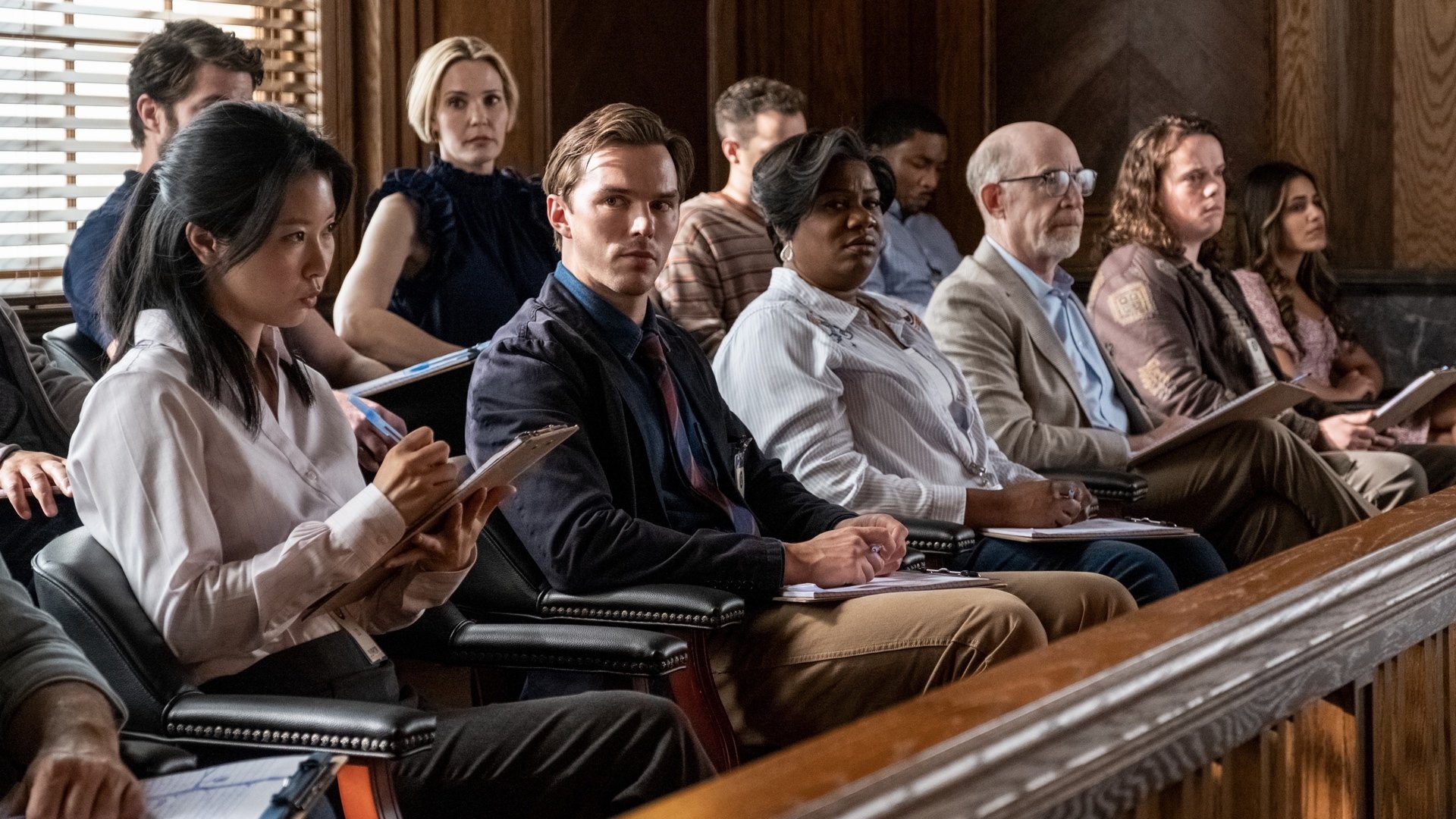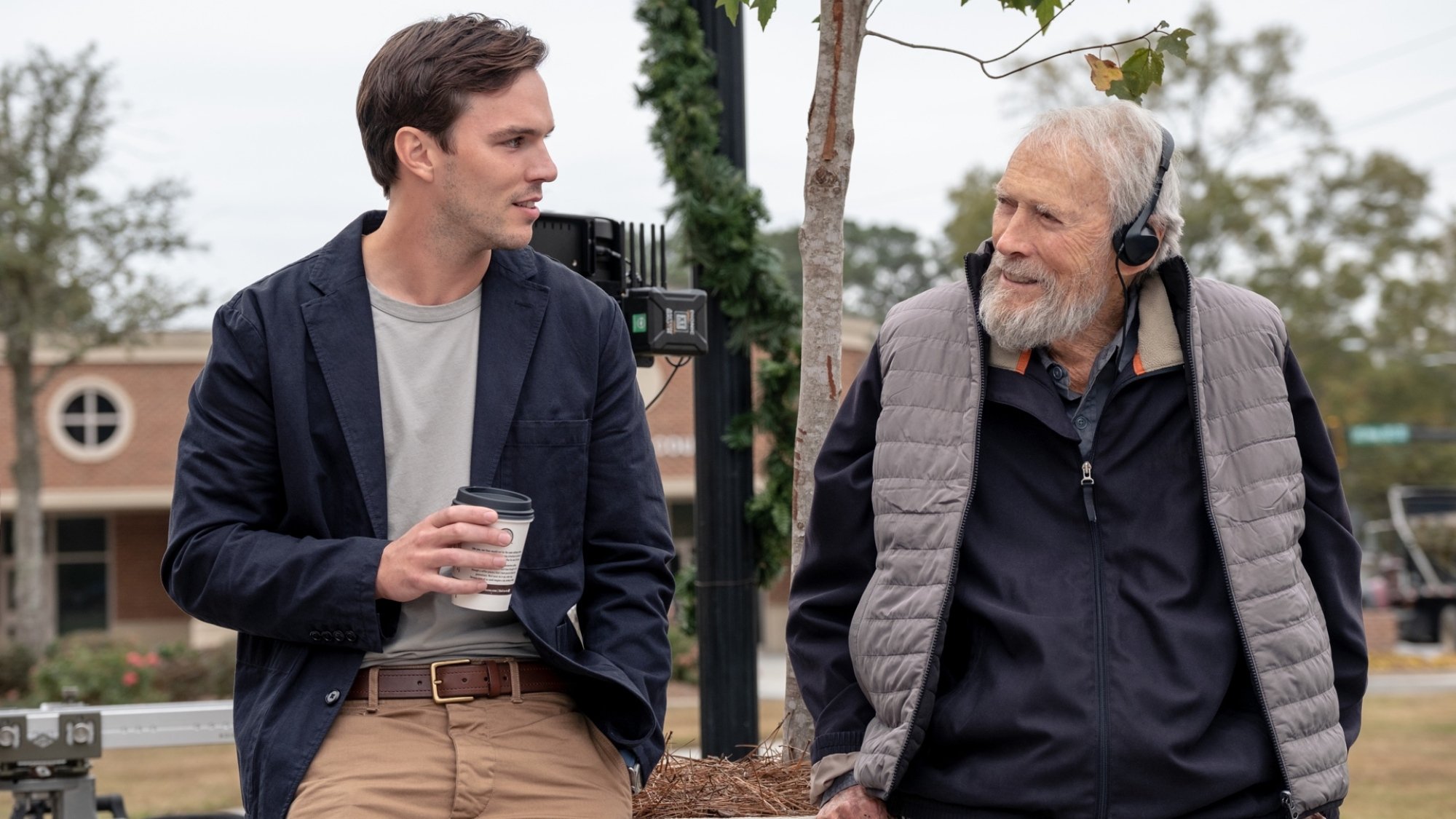
Juror #2 sets an incredibly high bar for itself, as a movie that lives in the shadow of 12 Angry Men. However, its struggles to differentiate itself from the Sidney Lumet classic yield intriguing contradictions. This is an appropriate outcome for a film so torn over notions of American justice, with which it wrestles by imbuing a familiar plot with a significant wrinkle: What if one of the 12 jurors realizes they might be responsible for the murder at hand?
Despite its growing pains, Juror #2 gradually grows more gripping and self-assured, taking the form of solid, mid-budget adult entertainment with a lot on its mind and heart — the kind of movie Hollywood seldom green-lights in 2024. If it really is the last thing Clint Eastwood ever directs (he is, after all, 94 years old), then it’s one hell of a swan song, despite Warner Bros.’ insistence on a paltry 50-screen release.
With its sense of careful, classical composition and emphasis on performance, Eastwood’s courtroom drama represents a kind of American filmmaking being left in the past, which is oddly fitting too. The past is where the movie’s subconscious resides, both as a tale of festering guilt and as a work that gazes lovingly upward at lofty American ideals that may no longer exist. Juror #2 reveals cracks in its own nostalgia through its riveting drama, and even through its own political flaws.
What is Juror #2 about?
On the surface, Georgia magazine writer Justin Kemp (Nicholas Hoult) seems to have it all, from the white picket fence to a doting, pregnant wife, Allison Crewson (Zoey Deutch). Their dynamic is fun and easygoing, and they even spend Halloween dressed up as the subjects of Grant Wood’s painting American Gothic, an idyllic piece of Americana. Their only seeming speedbump en route to parenthood is the minor inconvenience of Justin’s jury duty summons. The trial in question offers a stark contrast to Justin and Allison’s picturesque domestic bliss: A tattooed drug pusher, James Sythe (Gabriel Basso) — the character’s name evokes the grim reaper — is accused of bludgeoning his girlfriend, Kendall Carter (Francesca Eastwood), to death, and tossing her corpse off a shallow bridge.
The crime scene photos are gut-churning, but as a picture of the events is painted by diligent public defender Eric Resnick (Chris Messina) and ambitious assistant D.A. Faith Killebrew (Toni Collette) — another sharp, exacting name — Justin quickly realizes that he was at the same bar as Sythe and Kendall that rainy evening. He also recalls hitting something with his SUV in the darkness, right by a deer crossing, which led him to think little of the event at the time. Now, with the facts laid out before him, he isn’t so sure, and with Sythe’s innocence hanging in the balance, his decisions become paramount.
Jonathan Abrams’ screenplay establishes the movie’s premise quickly and with ruthless efficiency. In fact, Justin’s realizations and his acceptance of his role in Kendall’s death unfold rather quickly, to the point that something feels off about the movie’s pacing. However, as Justin tries to convince his fellow jurors to rethink their stances — at first, he’s the only holdout in a sea of guilty verdicts — a surprisingly deft balancing act emerges, wherein the drama of Justin’s remorse, and his dilemmas over how to proceed, become increasingly entwined with the nature of the law itself, and with its in-built presumptions. Granted, the case itself feels legally dubious at times; rare are the moments when it feels like anyone, let alone these specific jurors, might ignore its enormous holes. However, this only makes the movie’s argument more pointed, about what truly informs an individual’s factual reality.
The “what if?” hanging around Justin’s neck like an albatross isn’t one of whether he was responsible — he’s sure of this up front — but rather, what might happen should he come clean, and what his alternatives to doing so might be. As he seeks legal advice from a lawyer friend, Larry Lasker (Kiefer Sutherland), his conundrum becomes excitingly complicated, paving the way for unexpected personal drama. Not only does Justin have his wife and unborn child to care for, there are also elements of his past — hinted at through dialogue, but eventually revealed through flashbacks and Hoult’s heartrending personal confessions — that would, in theory, cast aspersions on his own character and idyllic façade, a fear made all the more pressing by how sure co-jurors seem of Sythe’s morality.
Justin, therefore, must sway 11 other individuals without tipping his hand. The film becomes a thrilling game of oration and of navigating fiery, idiosyncratic personalities. However, Eastwood never allows his story to become decoupled from larger concerns about the ethics of the law, and to what degree “innocent until proven guilty” truly holds when the accused, the attorneys, the jurors, and even judges don’t exist in vacuum. “To the justice system!” Resnick toasts midway through the film, somewhat tongue-in-cheek. “It isn’t perfect, but it’s the best we’ve got.”
Juror #2 is in a tug-of-war with 12 Angry Men.
Watching Juror #2 in no way requires homework, but familiarity with Lumet’s landmark legal drama (or the teleplay on which it’s based) makes it all the richer. There are, of course, overt plot similarities at the outset. Like Henry Fonda’s upstanding Juror No. 8, Justin is initially the only “non-guilty” voter, while his 11 co-jurors seem convinced otherwise. Although Justin’s motives are deeply personal — he knows the truth, and hopes to alleviate his own guilt — he takes a similar, step-by-step approach to Fonda’s character, asking the group to re-examine the evidence and their own biases before making a life-changing decision.
However, where 12 Angry Men is largely confined to the deliberation room over a single day, Juror #2 spans several days, nights, and locations. While this distinction is merely logistical, what it does with this departure ensures that Eastwood’s spiritual successor soon establishes its own identity. It has a wider purview, not only of the night of the crime — via numerous flashbacks that exhibit minor differences, depending on who’s telling the story — but of the trial itself, and its political entanglements. Killebrew, for instance, is running for District Attorney, and a guilty verdict favors her career.
The departures are mischievous too, from a storytelling standpoint. Several characters, including a retired detective and fellow juror named Harold (J.K. Simmons), begin looking into the case independently, and the question of how close they might come to discovering Justin’s involvement becomes a recurring throughline. However, the film’s thematic expansions prove thorny as well. In updating the make-up of the jury from 12 white men to a mix of men and women of different ethnicities, the film seems to overlook the ensuing racial entanglements, rather than folding them into its story.
None of the jurors are particularly excited to be there — a key starting point, as they (and the audience) are slowly convinced of how important their roles might be — but the two most adamant advocates of a guilty verdict happen to be Marcus (Cedric Yarbrough) and Yolanda (Adrienne C. Moore), the only two Black members of the jury. Not only are they utterly, even viciously convinced of Sythe’s guilt, they also place immense faith in the justice system without question. Yolanda is also afforded little interiority when it comes to her decision-making. While 12 Angry Men never quite got into racial specifics, its stray shot of the accused (John Savoca) and the charged language used by Lee J. Cobb’s hot-headed Juror No. 3 ensured that the specter of racism was ever-present. It is, therefore, more than a little strange that a modern movie set in a Southern U.S. state might not even consider the broader picture of how one’s experiences as a non-white person might differently shape their worldview when it comes to systems of legal justice.
On the plus side, Marcus becomes a greater focus of the film as things play out, so his reasoning feels more justified. But what’s especially interesting about his character is that not only is he the ostensible analogue of Cobb’s adamant third juror in 12 Angry Men, but there’s something distinctly Cobb-esque about him too. The actors could be related for all we know; their eyes are sunken and thoughtful in strikingly similar ways, and Yarbrough layers his temper with nuance and humanity, in the exact same way Cobb was known for doing.
In fact, eyes may be the most important element of Juror #2.
Clint Eastwood paints Juror #2 with subtle, masterful brush strokes.

Credit: Claire Folger / Warner Bros.
That the film lays its cards on the table within its first 30 minutes might seem surprising. However, it eschews all elements of mystery for a distinctive purpose. There’s no doubt in Justin’s or the audience’s mind about what actually happened, so the drama is born from the uncertainty of what Justin might do next — and whether it’ll be effective. The factual truth lies in the details, but the film’s emotional truths are just as lucid, and they’re often conveyed through performance.
Juror #2 may be a wordy film, but its dialogue is seldom expository, other than in scenes recounting the case. Each actor’s posture, their hesitance, and the turning of their mental and moral gears makes their characters’ motives crystal clear, even as the film’s own moral outlook grows murkier and more uncertain. You can tell exactly what a character is thinking just by observing their gaze, from the way they look at other people in the room, to the fleeting moments in which they avert their eyes, thinking silently to themselves. This is part of what makes the movie so enrapturing. The only time this technique is interrupted is when Eastwood and cinematographer Yves Bélanger pull purposefully from film noir, and use blinds and other physical elements to obscure Justin’s eyes in shadow. Uncertainty of plot, and of fact, briefly becomes the same thing as uncertainty of personal truth.
As the film nears its conclusion, Eastwood sprinkles more moments of doubt along the way, ensuring that anything remotely didactic about Juror #2 swiftly melts away. Hollywood movies about American systems tend to feature a saccharine optimism (à la The Report, which finds hope in the concept of justice even in a film about military torture). However, Juror #2 takes a more cynical bent, if a more realistic one, not only about the ways in which justice can be miscarried, but also the personally driven reasons the U.S. justice system often takes the shape it does.
And yet, Eastwood stresses the vital importance of personal duty within that system without ever getting lost in jingoistic notions. When the jurors feel uncommitted to their roles at first, the filmmaking is noncommittal too, unfolding at an unobtrusive distance and with mechanical proficiency. But as the drama becomes more personal, and more intimate, his aesthetic approach becomes imbued with a ferocious vitality.
The camera presses in on characters like Justin — and even on Allison, as if to question what, if anything, she knows — practically interrogating them, as it seeks to solve questions that may be unanswerable, in a system rife with imperfections, but one that strives to be “more perfect.” Juror #2 is old-school in its filmmaking, but it embodies a new school of thought for Eastwood, one briefly hinted at in Flags of Our Fathers but clarified with a newfound introspection and vulnerability. Deep-seated symbols and ideas become fluid, making space for captivating drama that both pays homage and paves its own path: a constant tussle between old and new.


















0 Comments